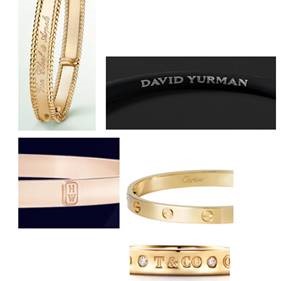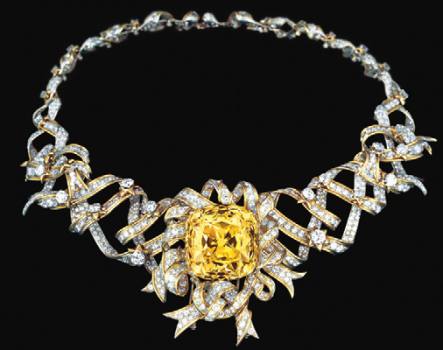What's in a name—a brand name, that is?
 Jewelry brand names carry an aura of high quality, of exclusivity. But today few items of jewelry are unique creations. A little history tells the story.
Jewelry brand names carry an aura of high quality, of exclusivity. But today few items of jewelry are unique creations. A little history tells the story.
Historical roots
Some brands have a reputation based on a history of excellence, of craftsmanship or invention.
Cartier, for example, has been one of the most prestigious jewelry manufacturers in the world. Founded in 1847, when Louis-François Cartier took over the workshop of his master, Adolphe Picard, Cartier jewelry soon gained a reputation among the wealthy and the aristocracy.
Edward VII of Great Britain called the company "the jeweler of kings and the king of jewelers". For his coronation in 1902, he ordered 27 tiaras from Cartier. The courts of England, Russia, Greece, Spain, Portugal and Siam officially granted Cartier their royal patronage.
Cartier created the first "purpose-designed" watch, a wristwatch for pilots, in 1904. Until then wristwatches were worn only by women, while men wore pocket watches. But a pioneer aviator complained to Cartier of the impracticality of pocket watches while flying. Cartier designed for him one of the first wristwatches for men, and Cartier wristwatches became a status symbol for the rich.
In 1949 the Duke and Duchess of Windsor purchased the famous Cartier panther brooch, which featured a 152-carat Kashmir sapphire. In 1987, sale of the brooch and other jewelry owned by the Duchess of Winsor was a major publicity event and gave another boost to the company. Advance media coverage included histories of the major pieces, along with descriptions of signed pieces by Cartier and Van Cleef & Arpels.
These and many other "firsts" and custom-designed pieces have gone into making the Cartier name highly regarded for innovation and craftsmanship—and display of wealth. It's been said that Louis-François Cartier built his reputation on knowing how to satisfy the most extravagant desires.
The Cartier family retained ownership of the firm until 1964.
Today Cartier is a wholly owned subsidiary of the Richemont Group. Richemont owns several of the world's leading companies in the field of luxury goods, specializing in jewelry and watches but also including clothing, writing instruments, firearms and ammunition.
Cartier operates more than 200 stores in 125 countries. The unique pieces that built the Cartier reputation are now supplemented by more bread-and-butter designs at prices more people can afford.
Tiffany has a similar path. The first store (then known as Tiffany & Young) opened in 1837 as a stationery and fancy goods emporium in New York. All items were marked with non-negotiable prices, an innovation at the time. The first day's sales totaled $4.98. It's come a long way since then.
The company soon introduced the iconic Tiffany Blue Box with its distinctive white bow, published its first catalog, and captured attention for its silver designs. It also introduced the 6-prong diamond solitaire engagement ring, a design that raises the stone up and into the light. Still today the design is known as the Tiffany setting.
In 1878 Tiffany acquired a 287.42ct rough fancy yellow diamond and had it cut into a 128.54ct polished gem. The astonishing gem was set into a necklace worn by Audrey Hepburn in publicity photos for Breakfast at Tiffany's in 1961, and it became known as the Tiffany Diamond. Publicity around this diamond set Tiffany's reputation as the ultimate luxury destination.
Like Cartier, Tiffany gained prominence and publicity because its jewelry was owned by famous people, by prominent families in society, and by Hollywood stars and entertainers. Most recently, Lady Gaga wore jewelry with the famous Tiffany Diamond at the 2019 Academy Awards.
As of 2018, Tiffany operated 93 stores in the US and 321 stores worldwide.
From its humble beginnings as a stationery store, it passed through several hands, including a brief ownership by Avon, the cosmetics company. In November 2019, LVMH announced its acquisition of Tiffany & Co. for $16.2 billion.
LVMH is a French multinational luxury goods conglomerate headquartered in Paris. It controls 60 subsidiaries, which include, besides jewelry, wine and spirits, fashions, leather goods, perfumes, and cosmetics. The conglomerate is said to operate over 2,400 stores worldwide.
Bloomberg News reported that LVMH would probably expand Tiffany's presence around the world "while boosting exclusivity and prices." According to another source, LVMH's current business plan is to tightly control the brands it manages in order to heighten the perception of luxury relating to their products.
The take-away
The perception of luxury is a huge factor for selling prestige brand-name merchandise. A perception of quality and exclusivity allows brands to maintain higher price points.
The image of prestige is based on publicity, on celebrity clientele, and on a history of unique creations at stratospheric prices. One imagines the jeweler craftsman bent over his table working into the night to produce the perfect piece.
However, when the brand sells at hundreds of outlets, as well as on the internet and in the auction market, it is apparent that most jewelry items are not unique designs of the kind that make the news and linger in the public's consciousness. The purpose of having many outlets is to lure a vast clientele, and this is accomplished by creating multiples at more affordable pieces. Industrial facilities worldwide produce attractive jewelry pieces in great numbers.
Tiffany's manufacturing facilities produce about 60% of the merchandise sold, while the balance, including its rose-gold jewelry, comes from third parties overseas.
This is not an argument against the quality of Tiffany or Cartier or any brand-name jewelry. We are just pointing out to insurers that brand name jewelry often carries a higher price than a piece of the same quality purchased elsewhere.
This was, in fact, at issue in the Tiffany-Costco suit involving Costco's sale of diamond rings in a Tiffany setting. What was at stake in the suit was use of the Tiffany name (the prestige factor), not the quality of the jewelry sold by Costco.
To a company like Tiffany or Cartier, the name itself has value. The issue for insurers is: When your coverage promises replacement with like kind and quality, does that include brand — especially on items made for but not by the branded company?
You may wonder how a seller justifies charging, say, $60,000 for a piece of jewelry available elsewhere for $40,000 — and why a consumer is willing to pay it. The increased price might be looked at as payment for the luxurious shopping experience, or the thrill of receiving that little blue box, or the pride of owning a brand-name item.
These experiences are not the jewelry. They are the jewelry's "sentimental value," which is not insurable.
FOR AGENTS & UNDERWRITERS
For any high-value jewelry, insist on a detailed, descriptive appraisal, such as on JISO 78/79. This descriptive information is what you need to price a replacement. Especially important are the stampings/engravings of quality and trademarks, which today can easily be conveyed with a smart phone picture.
You may want to base premiums on the purchase price, but an adjuster will usually base a settlement on the jewelry's value at time of loss (not exceeding the scheduled limit).
Ask for the sales receipt. Counterfeit jewelry abounds, so pay attention to these red flags:
- Was the jewelry bought on eBay or anywhere online?
- Is the valuation far higher than the purchase price?
- Is the valuation on a printed certificate supplied by the seller?
If the answer to any of these questions is Yes, and the jewelry is high-priced, insist on an appraisal from an independent appraiser who is a GG, FGA+ or equivalent, and who has advanced training in appraising for insurance, such as a Certified Insurance Appraiser™(CIA).
While consumers may think of their jewelry as unique, most jewelry items you insure can be reproduced if the design is not patented. See Myths, Lies and Half-truths for details.
Tiffany produces its own diamond grading reports, based on the GIA color and clarity grading systems. The company may be using GIA reports internally, but the customer receives a Tiffany report. Given that there can be a range for any grade, Tiffany selects stones on the high end of the grade.
Diamonds (the gems themselves, not the jewelry) sometimes carry brand names. This is a separate issue, which we've discussed in Branded Diamonds.
FOR ADJUSTERS
The internet is full of merchandise that carries a brand name but comes so extremely cheap that one might think customers would realize it isn't authentic. Yet the prestige of a luxury brand name pulls them in. For jewelry, and other luxury merchandise, be on guard against fraud.
Don't take brand names at face value. Look for evidence of authenticity. There is big money in faking big-name jewelry. Inspect all documents and use every means possible to determine whether the jewelry is of the stated brand and quality.
If the jewelry was purchased on the internet, be very suspicious of the stated quality and valuation.
A huge discrepancy between selling price and valuation is a strong indication of inflated valuation.
Adjusters would be well served to learn what a "bill of material" is and how the "cost approach" is applied. This is especially important in partial replacements, as for a lost diamond. The insured may want the replacement to be "a Tiffany diamond," but you can replace with a diamond of like kind and quality. Tiffany and similar jewelry manufacturers do not cut their own diamonds.
©2000-2025, JCRS Inland Marine Solutions, Inc. All Rights Reserved. www.jcrs.com



